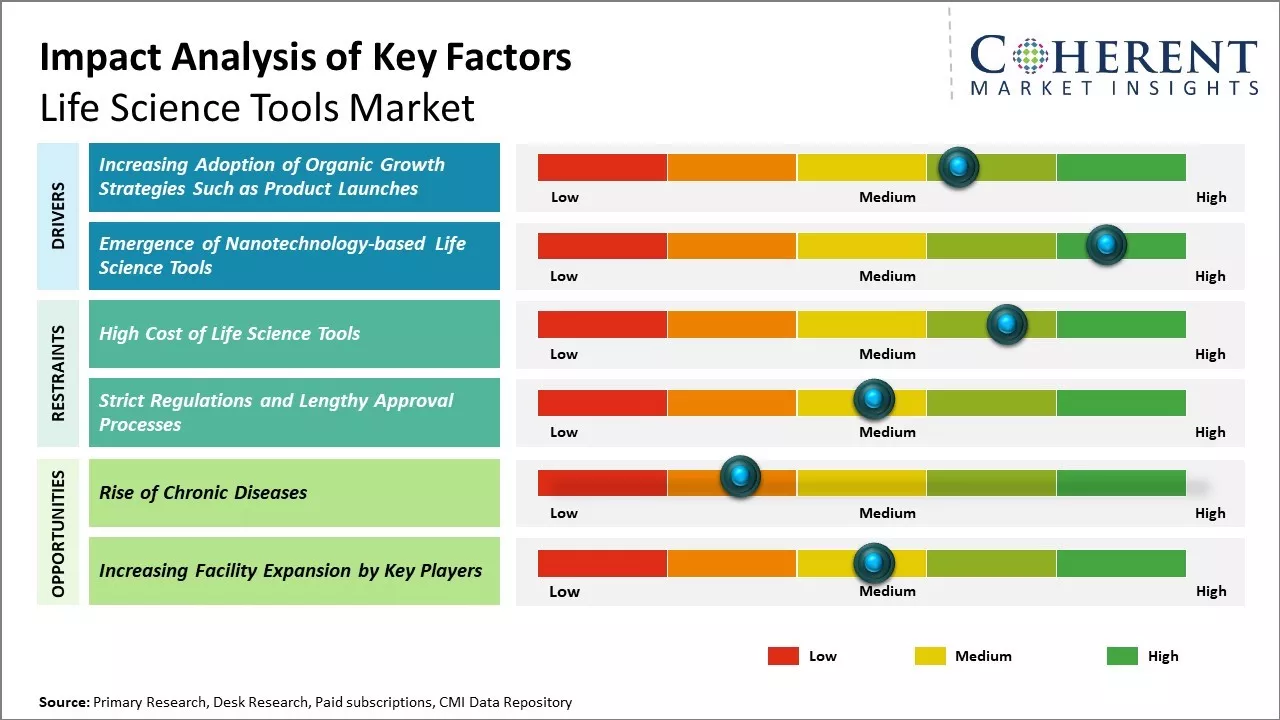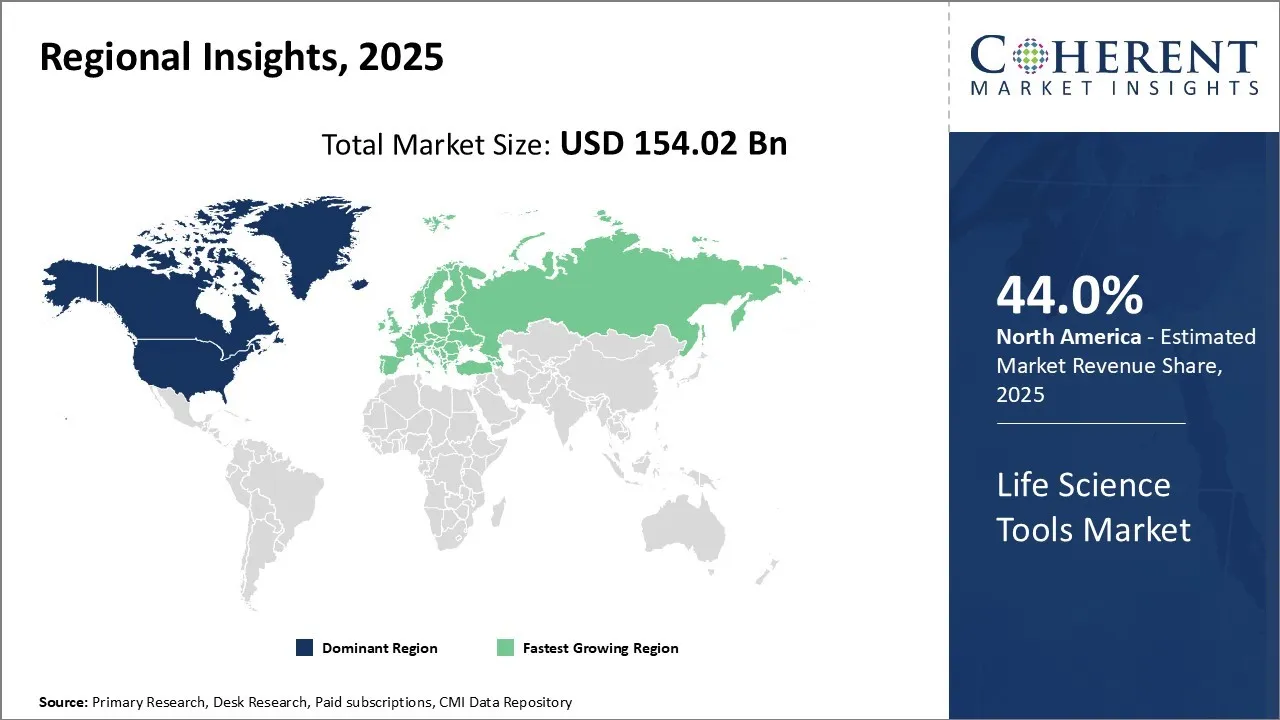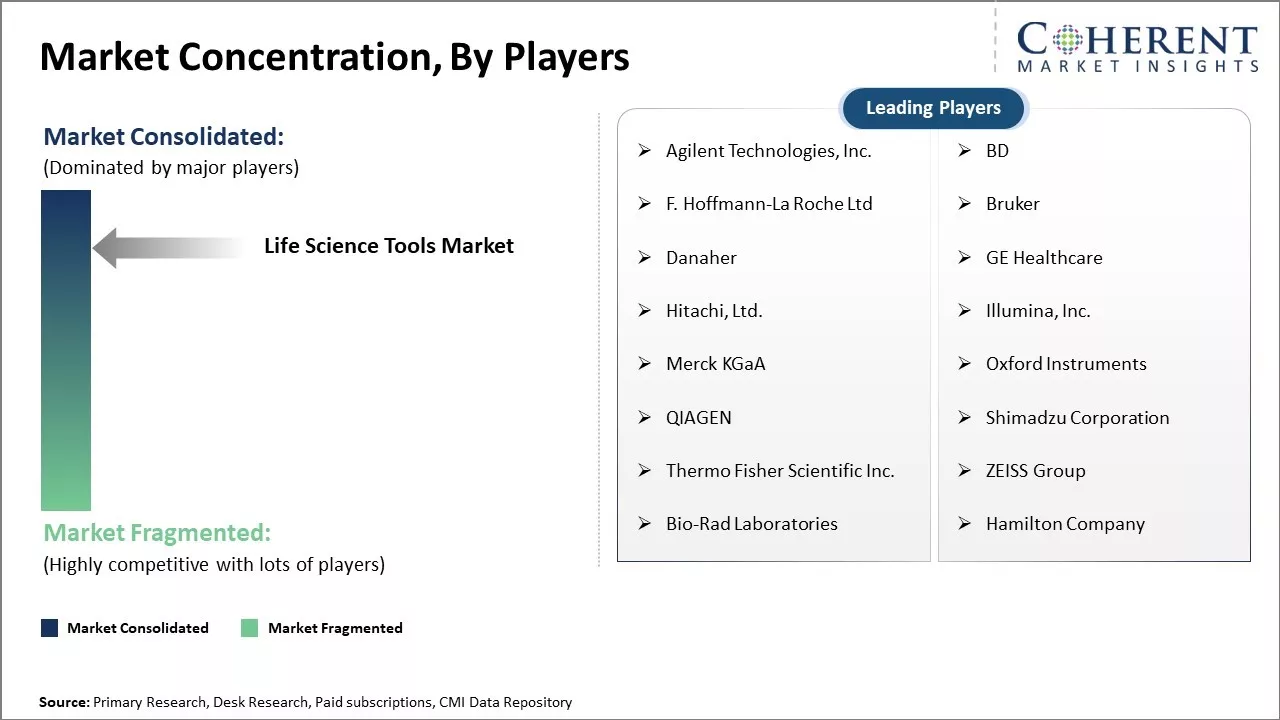Life Science Tools Market is estimated to be valued at USD 154.02 Bn in 2025 and is expected to reach USD 364.83 Bn in 2032, exhibiting a compound annual growth rate (CAGR) of 13.1% from 2025 to 2032.

To learn more about this report, Download Free Sample
The life science tools market is expected to witness positive growth over the forecast period. Key factors, such as increasing R&D spending on drug development, rise in need for cost containment in drug discovery, growth of molecular diagnostics, and technological advancements, are expected to drive the demand for life science tools. Growing focus on precision medicine and companion diagnostics is further expected to propel the market growth. Additionally, factors, such as increasing pharmaceutical outsourcing and rising life expectancy, are anticipated to present lucrative growth opportunities for market players in the coming years.
For instance, in January 2025, Clarivate Plc, announced the launch of DRG Fusion, an innovative platform to support commercial analytics in life sciences. Powered by integrated real-world data and built by clinical and data science experts.
|
Event |
Description and Impact |
|
Rapid Adoption of Digital and AI Technologies |
|
|
Adoption of AI and Machine Learning in Automation |
|
Uncover macros and micros vetted on 75+ parameters: Get instant access to report
The product segment includes consumables, instruments, and services. The consumables segment is estimated to hold 48.2% share of the market in 2025 owing to their indispensable role and adaptable nature across various stages of research and development. Being consumable in nature, these tools require regular replenishment which ensures recurrent sales.
Their wide applicability across diverse life science procedures such as sample preparation, nucleic acid purification, cell culture and imaging simplify experimental workflows. Thus, increasing new product launches by key market players are expected to drive the segment growth over the forecast period.
For instance, in May, 2022, Thermo Fisher Scientific Inc., a global supplier of scientific instrumentation, announced the launch of a new collection of qPCR biopharma products to accelerate drug development and meet the growing demand for novel biologics.
The comprehensive QualTrak suite of qPCR tools consist of a world-class selection of proven applied biosystems solutions including QuantStudio 6 and 7 Pro real-time PCR systems and TaqMan and TaqPath master mixes and assays to empower the biopharmaceutical industry.
The technology segment includes genomics, proteomics, cell biology, stem cell research, and immunology. The cell biology sub-segment is expected to hold 44% of the market share in 2025. Cell biology dominates due to its ability to provide comprehensive cellular insights. Understanding physiological and pathological processes at the cellular level is pivotal for deciphering biological mechanisms and disease pathways.
Cell biology tools facilitate interrogation of individual cells, their organization into tissues and complex multicellular structures. Additionally, advances in microscopy, fluidics, mass cytometry, and other technologies have augmented traditional bulk cell analysis. Multi-parametric imaging now illuminates cellular structures, interactions and dynamics in exquisite detail in both 2D and 3D. Such insights are indispensable for phenotypic drug discovery, biomarker evaluation and more.
As cellular complexity comes to the fore, understanding how aberrant states manifest at the single-cell level is poised to transform medicine. Cell biology tools facilitate mining health and disease from a systems perspective. Their ability to unravel heterogenous responses and discern rare cellular subpopulations will be immensely valuable for personalized therapeutic strategies.
The application segment includes drug discovery and development, clinical diagnostics, genomic and proteomic research, cell biology research, and others. The drug discovery and development sub-segment is expected to hold 32.3% of the market share in 2025 which is driven by associated R&D investments. Life science tools play an indispensable role throughout the drug pipeline from target identification and validation to lead optimization, preclinical, and clinical development.
Innovations in screening approaches allow evaluating thousands to millions of compounds against molecular targets simultaneously. This has augmented hit rates and reduced costs of early discovery. Technologies like RNA interference, CRISPR, and organ-on-chip now enable modeling disease mechanisms with greater fidelity. Such advanced models will translate basic research insights into novel targets and pathways more efficiently.
Furthermore, as drug development timelines compress, life science tools empower accelerated pharmacokinetic, pharmacodynamics, and toxicological profiling. They assist identifying development candidates rapidly based on human-relevant data versus traditional animal models. Such human-centered approaches boost program success rates and commercial viability.

To learn more about this report, Download Free Sample
North America remains the dominant region in the global life science tools market and is anticipated to hold 44.0% of the market share in 2025. The presence of major players and strong research infrastructure has propelled the market growth over the years. The region is a hub for the biotechnology and pharmaceutical industries with strong government funding for research activities.
Several top universities in the U.S. are actively engaged in research collaborations with industry players, driving innovation. With large healthcare spends, the demand for advanced tools to accelerate drug discovery and development processes continues to rise in the region. Increasing investments by the market players is expected to foster the market growth over the forecast period.
For instance, in June 2022, Illumina, Inc., a biotechnology company, announced its investment in Time Boost Capital, a USD 30 million genomics venture fund that offers start-ups that have completed the Illumina Accelerator Cambridge matching funding in order to make advancements in human health. Illumina, Inc. joined a select group of the U.S. and European investors in the life sciences fund, including cornerstone investor LifeArc.
Asia Pacific has emerged as the fastest growing regional market, led by countries such as China and India. Massive government investments to strengthen research capabilities and develop the local manufacturing sector have boosted the adoption of tools across various application areas. The rising spends on healthcare by these nations along with increasing disease prevalence rates is propelling market expansion.
Prominent global players have set up manufacturing bases in the region to cater to the growing demand as well as benefit from lower production costs. This has made high-end tools more affordable and assessable for domestic customers. Meanwhile, export opportunities for Asian products continue to rise as the quality standards match international benchmarks. The pool of well-educated and English-speaking talent base further reinforces the growth trajectory of the market.
Advancements in genomics, precision medicine, and diagnostic technologies are major growth drivers. Government Support and Investment: Countries such as Germany, the UK, France, Italy, Spain, and Switzerland lead the market, supported by substantial public and private investment in research infrastructure and biotechnology. Rising rates of chronic diseases and increasing demand for personalized therapies are boosting the market
Due to strong government support, significant healthcare spending, a concentration of prestigious academic institutions, and industry giants like Thermo Fisher Scientific, Agilent Technologies, and Illumina, the United States leads the world market for life science technologies. The nation is home to important life science clusters like Boston-Cambridge and the Bay Area and enjoys robust research support, particularly from organizations like the NIH.
With the help of a rapidly growing biotechnology industry, increased government and private investment in R&D, and a sizable, highly qualified workforce, India is emerging as a significant market for life science equipment. With an emphasis on affordable solutions for drug development, personalized medicine, and diagnostics, the nation is seeing growth in both domestic production and innovation.
Due to significant government investment in biotechnology, rising healthcare costs, and an increase in the number of biotech firms, China is quickly becoming a major player in the market for life science equipment. The nation's life sciences ecosystem has been greatly enhanced by programs like "Healthy China 2030".
| Report Coverage | Details | ||
|---|---|---|---|
| Base Year: | 2024 | Market Size in 2025: | USD 154.02 Bn |
| Historical Data for: | 2020 To 2024 | Forecast Period: | 2025 To 2032 |
| Forecast Period 2025 to 2032 CAGR: | 13.1% | 2032 Value Projection: | USD 364.83 Bn |
| Geographies covered: |
|
||
| Segments covered: |
|
||
| Companies covered: |
Agilent Technologies, Inc., BD, F. Hoffmann-La Roche Ltd, Bruker, Danaher, GE Healthcare, Hitachi, Ltd., Illumina, Inc., Merck KGaA, Oxford Instruments, QIAGEN, Shimadzu Corporation, Thermo Fisher Scientific Inc., ZEISS Group, Bio-Rad Laboratories, Hamilton Company |
||
| Growth Drivers: |
|
||
| Restraints & Challenges: |
|
||
Uncover macros and micros vetted on 75+ parameters: Get instant access to report
Increasing adoption of organic growth strategies such as product launches by the key market players is expected to drive the global life science tools market growth over the forecast period. For instance, in September 2022, F. Hoffmann-La Roche Ltd., a pharmaceutical company, launched the Digital LightCycler System (DLS), a digital polymerase chain reaction (PCR) system that is designed to aid in diagnostics for cancer, genetic disease, and infection. It detects the disease accurately and evaluates trace amounts of specific DNA and RNA targets that are not typically detectable by conventional PCR methods.
Nanotechnology is increasingly revolutionizing the life sciences field in pathbreaking ways. The ability to manipulate and study matter at the nanometer level is opening new vistas for advanced research in areas like genomics, proteomics, and molecular biology. Life science tools that work at nanoscale levels are allowing scientists and researchers to gain deeper insights into complex biological processes and systems down to the level of single molecules and cells.
Several life science tool companies are leveraging nanotechnology to develop highly innovative and sophisticated lab equipment, instruments, and devices. One prominent area is nanoscale biosensors that can detect and analyze biomolecules with unprecedented sensitivity.
Researchers are also seeing the benefits of nanotechnology-enabled high-throughput screening systems for applications like drug discovery. Atomic force microscopes and nanoscale microscopy tools are generating never-before fine-scale images of living tissues and enabling exploration of cellular functions at molecular resolution.

To learn more about this report, Download Free Sample
There is a surge in the adoption of advanced technologies such as next-generation sequencing (NGS), CRISPR gene editing, mass spectrometry, and lab automation. These innovations are enabling breakthroughs in genomics, proteomics, and synthetic biology, which are driving demand for sophisticated life science tools.
The growing global population and rise of chronic diseases is driving the demand for new diagnostic tools and therapies. This presents opportunities for life science tool companies who can help enable new discoveries. Companies developing tools focused on precision medicine and personalized healthcare will be positioned for growth. There is also a need for multi-omics tools that combine different types of data, from genomics to proteomics.
*Definition: The life sciences tools industry encompasses a wide range of equipment and technologies crucial for research and development in various scientific disciplines like biology, chemistry, and medicine. These tools include instruments, reagents, and consumables used in genomics, proteomics, and metabolomics to analyze genes, proteins, and other molecules for drug discovery, diagnostic tests, and therapies.
Share
Share
About Author
Komal Dighe is a Management Consultant with over 8 years of experience in market research and consulting. She excels in managing and delivering high-quality insights and solutions in Health-tech Consulting reports. Her expertise encompasses conducting both primary and secondary research, effectively addressing client requirements, and excelling in market estimation and forecast. Her comprehensive approach ensures that clients receive thorough and accurate analyses, enabling them to make informed decisions and capitalize on market opportunities.
Missing comfort of reading report in your local language? Find your preferred language :
Transform your Strategy with Exclusive Trending Reports :
Frequently Asked Questions
Joining thousands of companies around the world committed to making the Excellent Business Solutions.
View All Our Clients